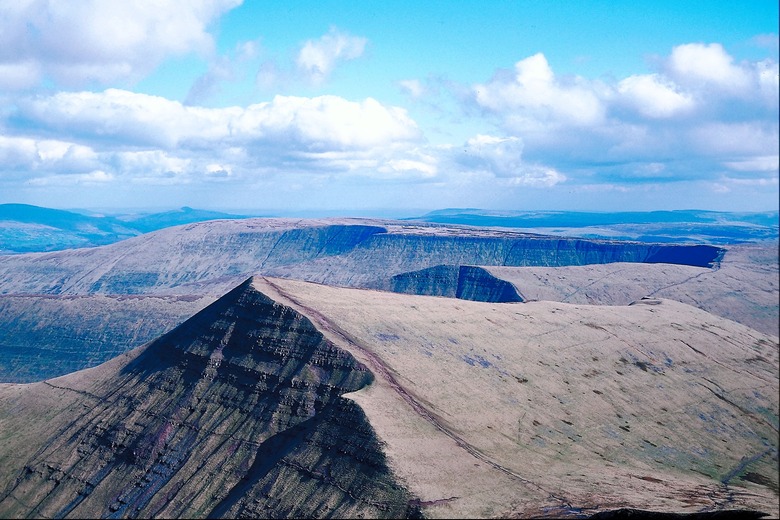How An Earthquake Affects The Biosphere And Hydrosphere
The earth is made of huge moving pieces called tectonic plates that push against each other with great force. When one plate suddenly gives way to another, an earthquake occurs. Earthquakes affect the biosphere, the layer of Earth's surface in which life can exist. This includes all the water on or near Earth's surface, the hydrosphere. An earthquake's severity increases as its magnitude (its relative size as measured by a seismograph) increases and decreases as distance from the fault that caused it increases.
Seismic Waves
Seismic Waves
Most destruction of human lives in an earthquake results from the collapse of buildings, which is caused, in the language of physics, by a combination of body and surface waves. These waves cause the ground, and buildings resting upon the ground, to vibrate in a complex way. The waves travel up through building foundations and fight their inertia, or resistance to change. Stress is placed upon walls and joints, which destroys buildings that have not been built to withstand it.
Landslides
Landslides
Earthquakes can cause several types of landslides. The most common type of earthquake-induced landslide is a rock fall that occurs on steep slopes. Soil avalanches can occur on steep slopes that are generally stable, but where the soil is fine-grained and not strongly held in place. Underwater landslides can occur in deltas and can be responsible for damage to port facilities, as happened in Seward, Alaska in 1964.
Liquefaction
Liquefaction
Sandy soils that are normally stable and supportive can mix with water during an earthquake and become like quicksand — similar to what happens when you wiggle your toes in sand near the waterline at the beach. The result is liquefaction, which can manifest in a number of ways. A lateral spread is the sideways movement of large areas of soil on a gentle slope. Soil can move from 10 to 150 feet and can be destructive to underground pipelines. A flow failure is a layer of intact material that rides above a layer of liquefied soil, on land or underwater. Moving at as much as tens of miles per hour, flow failures can be catastrophically destructive. Soil that normally supports a building or other structure experiences loss of bearing strength when liquefied, allowing the supported structure to settle and tip. Sand blows occur when prolonged shaking of liquefied strata causes eruption of water from the sand layer.
Hydrosphere
Hydrosphere
Earthquakes may modify groundwater flow from springs by causing expansion and contraction of the aquifer from which the spring flows. The change may be either temporary or permanent. Earthquake faults may also result in offset stream channels and sag ponds, water that collects in the depression along a strike-slip fault line. By far the largest effect of earthquakes in the hydrosphere is the tsunami, which means "harbor wave" in Japanese. Tsunamis result from a sudden vertical shift in the ocean floor, usually where tectonic plates meet, that can be caused by an earthquake, a landslide or a volcano. A small wave, generally only a few feet tall, is generated. As the depth of water decreases near land, however, the height of the wave increases many times, and is capable of causing massive destruction hundreds or thousands of miles from the site of the earthquake. A miniature form of tsunami that can occur in lakes is called a seiche.
Landforms
Landforms
Large earthquakes may increase the height of mountains by anywhere from a few inches to a few feet. When one side of a fault moves up relative to the other side of the fault, it creates a steep ridge called a scarp. As repeated earthquakes occur along a fault, the rock along the fault is broken and becomes subject to erosion that, over time, can form a valley in the fault zone. A fault can interfere with groundwater movement, raising or lowering its level and causing ponds or springs to form. A strike-slip fault on the surface of the ground displays as a long shallow disruption called a moletrack.
Cite This Article
MLA
Cleary, Laurel. "How An Earthquake Affects The Biosphere And Hydrosphere" sciencing.com, https://www.sciencing.com/earthquake-affects-biosphere-hydrosphere-8710606/. 13 March 2018.
APA
Cleary, Laurel. (2018, March 13). How An Earthquake Affects The Biosphere And Hydrosphere. sciencing.com. Retrieved from https://www.sciencing.com/earthquake-affects-biosphere-hydrosphere-8710606/
Chicago
Cleary, Laurel. How An Earthquake Affects The Biosphere And Hydrosphere last modified March 24, 2022. https://www.sciencing.com/earthquake-affects-biosphere-hydrosphere-8710606/
